West Nominee: Steve & Wylda Cafferata from Oregon
What makes them outstanding?
The Cafferatas have a deep
back ground in forestry. For 35 years, Steve served as a professional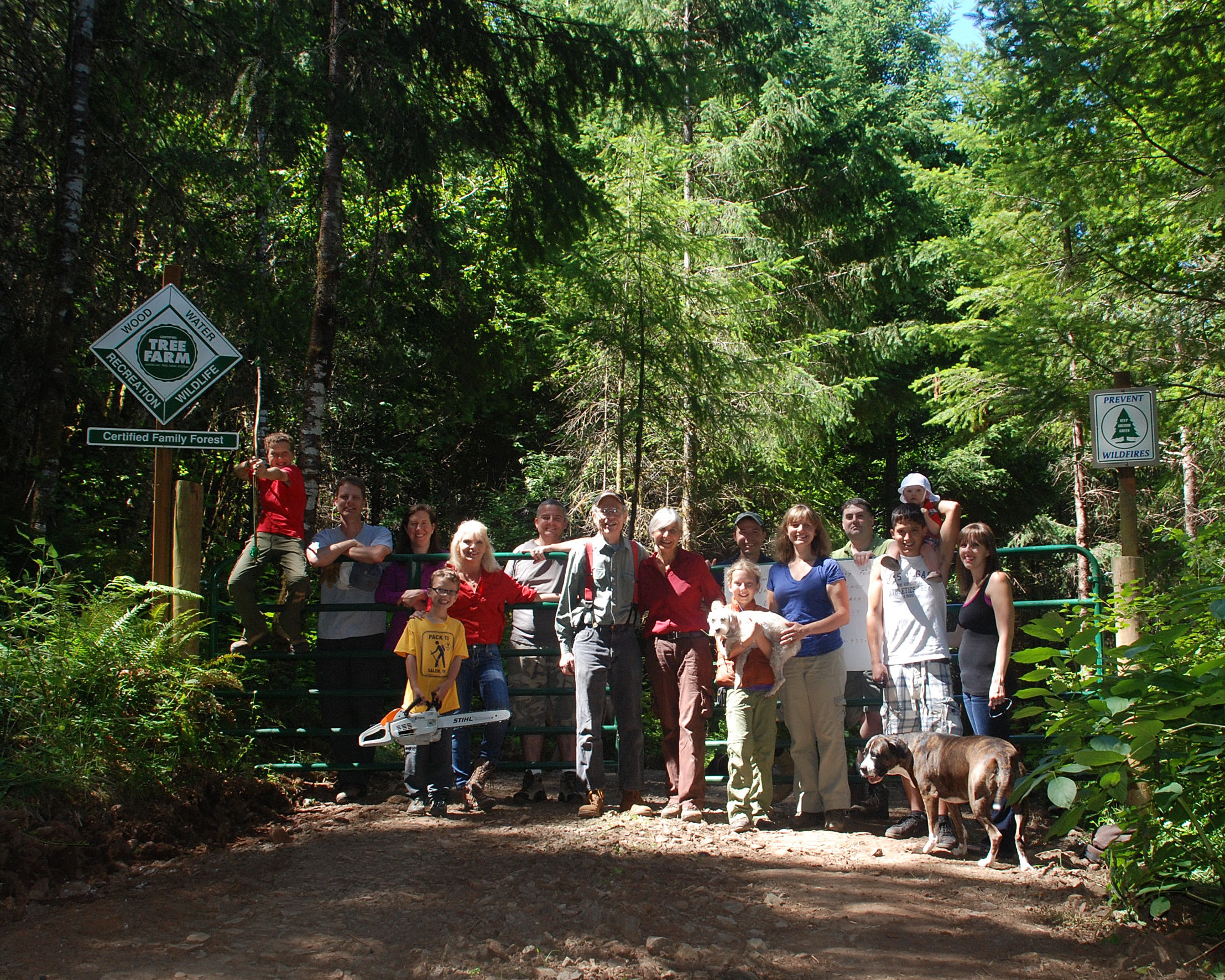 forester
for Weyerhaeuser. He has a wealth of forestry knowledge and a solid background
in forest science, which he willingly shares with others. The family has many
natural resource experiences. Son, Mike Cafferata, is a forester with the
Oregon Department of Forestry and Daughter, Francesca Coe, is a consulting
wildlife biologist. Wylda had a successful career in education and has become a
Master Woodlands Manager through Oregon State University’s Forestry Extension.
Using their skills, the Cafferatas have put together an exemplary forest
management plan they willingly share with others. The results are great
attention to wood, water, recreation, and wildlife and all the other attributes
found in a working forest. The entire family, including the third generation,
is involved in the management and enjoyment of the property.
forester
for Weyerhaeuser. He has a wealth of forestry knowledge and a solid background
in forest science, which he willingly shares with others. The family has many
natural resource experiences. Son, Mike Cafferata, is a forester with the
Oregon Department of Forestry and Daughter, Francesca Coe, is a consulting
wildlife biologist. Wylda had a successful career in education and has become a
Master Woodlands Manager through Oregon State University’s Forestry Extension.
Using their skills, the Cafferatas have put together an exemplary forest
management plan they willingly share with others. The results are great
attention to wood, water, recreation, and wildlife and all the other attributes
found in a working forest. The entire family, including the third generation,
is involved in the management and enjoyment of the property.
The family actively participates in volunteer organizations that benefit family forest owners. The Cafferatas are well known and respected in their community and at the state level. Their actions set an example for others to follow when they volunteer their time and willingly take leadership roles when needed. Steve and Wylda are frequent participants at events at the state capitol when called upon by organizations representing family forest issues. They will visit their representatives and testify at hearings, when needed. The Cafferatas excel in their forest management, their leadership roles in family forest organizations, and their commitment and involvement in their local and state communities.
Tree Farmer story
The Cafferata story begins in the 1940s when a little boy in Chicago read The New House in the Forest and a little girl in Los Angeles read the same little golden book. Fast forward fifteen years to Berkeley where the boy enrolled in the College of Forestry and the girl joined the hiking club. They met, and dreamed that one day they would own and manage their own forest. Fast forward again to 2009, when Steve and Wylda Cafferata, after raising four children and working for 35 years in their professions, realized their dream by purchasing 79 acres of forestland. The land had been logged, replanted haphazardly, and then neglected for decades, so they set to work to bring the land under management. Over the next seven years, they added three more parcels, 33 acres in Benton County, 112 acres in Lane County, and 120 acres in Lincoln County. They developed management plans for each and certified them to the American Tree Farm System in 2010, 2013, 2014, and 2017.
During their careers, Steve
and Wylda worked diligently in their professions. While serving in the Navy,
Steve joined Society of American Foresters (SAF) and then earned an MF Degree
in forest management. For 35 years, he served as district forester and forest
manager for Weyerhaeuser. In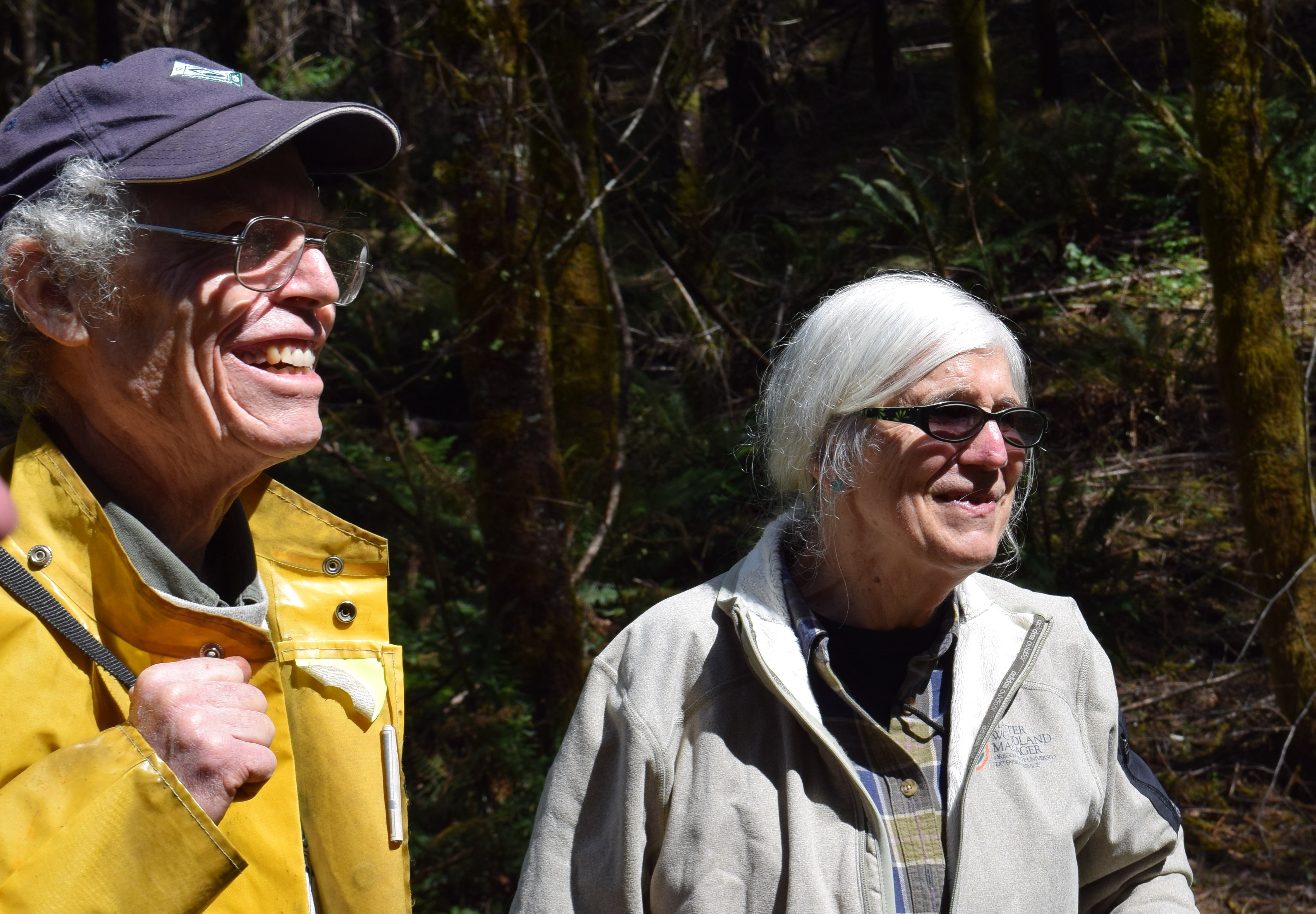 2002, he was named SAF Outstanding Field Forester
of the Year and elected an SAF Fellow in 2003. Steve remains active in SAF. He
also served as president on the Eastern and Western Lane Fire Protection
Associations working closely with public and private forest agencies. He was
Scout Master of BSA Troop 417.
2002, he was named SAF Outstanding Field Forester
of the Year and elected an SAF Fellow in 2003. Steve remains active in SAF. He
also served as president on the Eastern and Western Lane Fire Protection
Associations working closely with public and private forest agencies. He was
Scout Master of BSA Troop 417.
Wylda helped found a cooperative pre-school, taught middle school and high school, served on numerous local and state educational committees, and led both Cub Scout and Girl Scout troops. She is a member of Phi Beta Kappa. Wylda completed her Master Woodland Managers training in 2014 and has recorded over a hundred volunteer hours per year in that capacity. She is a member of WOWnet (Women Owning Woodlands) and represented them on a panel for the World Forestry Center’s Hagenstein Lecture in 2017. She is a Board Member and serves as secretary for Forests Today & Forever (FTF), a Lane County non-profit that promotes forestry education. Both she and Steve volunteer for FTF’s field days that teach 1500 middle school students a year. She helped create a reading list on environmental issues for Oregon Forest Resources Institute (OFRI), a state organization whose purpose is to educate landowners and the public on forestry. Along with her daughter, she presented a workshop on using poetry in forestry-education classes. She is working to re-establish forestry curriculum in the local school system. Currently she is preparing a presentation on forestry education for the up-coming National SAF Convention.
Although they moved into new spheres, neither Steve nor Wylda consider themselves retired. Steve served for eight years on the local Volunteer Fire District Board. He is the volunteer forester for the Boy Scout Oregon Trail Council’s 1000-acre forest, where he and Wylda do much of the manual field work themselves. Wylda was elected to the Pleasant Hill School Board in 2006. She is currently the Board Chair and serves on several school-related committees.
In 2009, Steve and Wylda joined the Oregon Small Woodlands Association (OSWA), a non-profit that represents family forest owners in Oregon. They are active in OSWA’s Lane County chapter: Wylda serves on the LCSWA Board as secretary, and Steve serves on OSWA’s Governmental Advisory Committee. Both have attended legislative hearings and testified at the State Capitol on topics of interest to family forest owners. They were selected as Lane County’s Volunteers of the Year in 2016, and Steve was awarded OSWA’s Riggin Slinger Award in 2017, the highest award presented to an OSWA member.
Steve represents all of Oregon’s family forest owners on the State Emergency Fire Cost Committee (EFCC). The four-member committee, appointed by the State Board of Forestry, determines how to spend private landowner dollars collected from property assessments and harvest taxes to fund private forest owners legal responsibility for large fire costs. The Oregon Forest Land Protection Fund is liable for up to $13.5 MM per annum. Steve has earned the reputation for efficient fiscal responsibility and is well-respected by the Oregon Department of Forestry and members of the forest land-owner community. He is an active ATFS Inspector with several inspections a year. He was selected Oregon’s Tree Farm Inspector of the Year in 2015.
Steve represents the Pleasant
Hill Sub-Fund on the Oregon Natural Resource Education Fund (ONREF) Committee,
associated with the Oregon Community Foundation providing grants for Oregon
projects. ONREF was established to provide grants for sustaining natural
resource 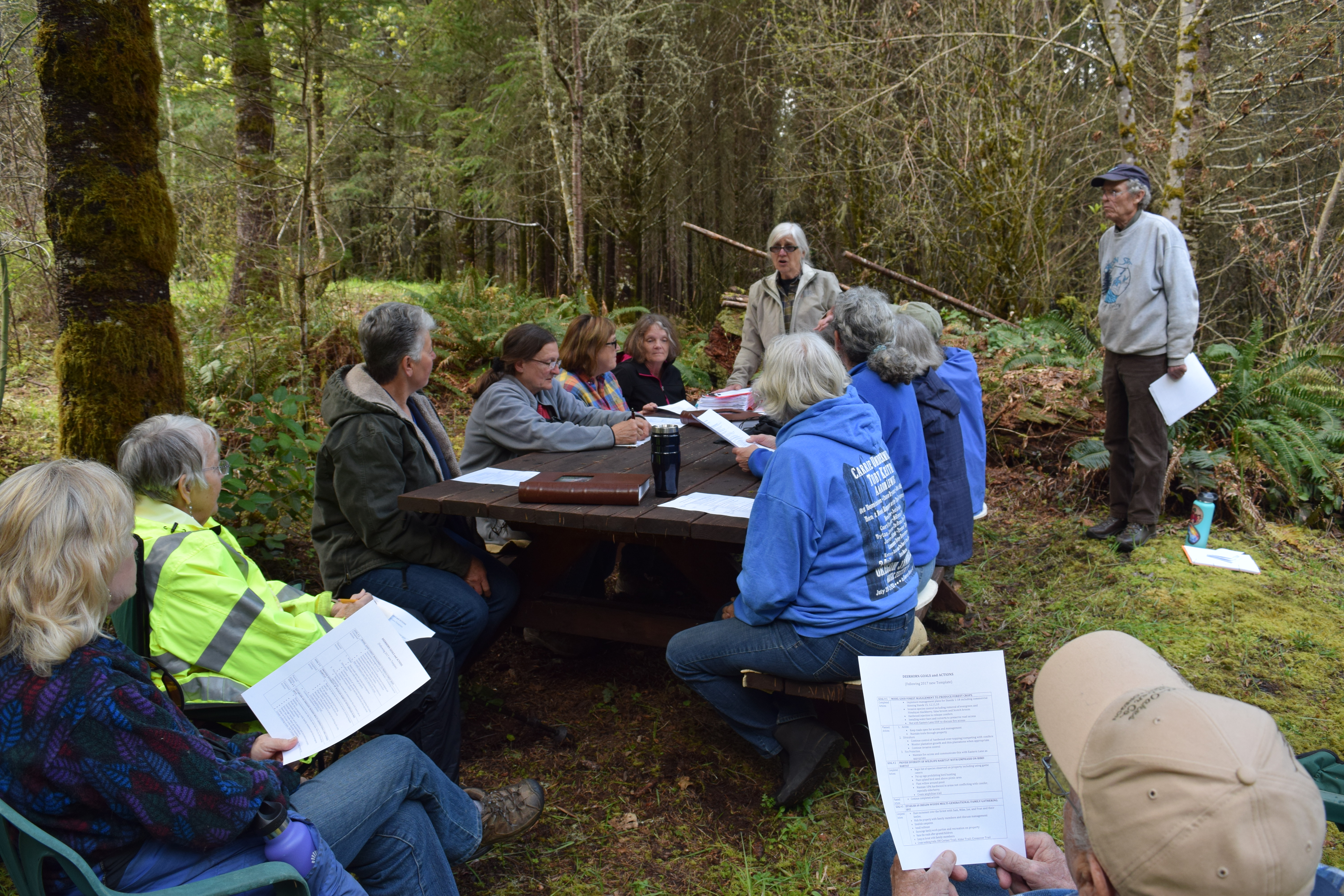 education programs in Oregon high schools.
education programs in Oregon high schools.
Steve and Wylda’s children participate actively on the Cafferata Family Forest. Francesca Coe, their daughter, is a certified wildlife biologist whom many forest landowners consult on wildlife issues. She prepares the wildlife sections of the family management plans. Their son Mike is a District Forester for the Oregon Department of Forestry and is heavily involved in all family management planning including growth models and economic analyses. Their son Joe works in Washington DC, but vacations in Oregon to work on the tree farm. He is adept at helping track progress toward goals. Their son Sam is the family recreation specialist who often camps on the tree-farms. Additionally, he works on the property designing and creating management tools, including a spray shield, ATV trailer, and vexar-tube installer. All the spouses, Jenny, Julie, Ali, and Matt, participate as well. The three grandchildren, Allison, Anthony, and Alex, are at home on the forest. They assist with forest activities, and look forward to days working on the forest.
Both Steve and Wylda believe that their tree farmer story is just beginning. They anticipate many more happy years implementing their management plans and passing the tree-farm along to their children, grandchildren, and generations to come so that the healthy forest they helped create will be sustained.
For the following areas describe how the landowner's management addresses it
Wood: One of the goals of the Deerhorn property is growing and harvesting trees. When purchased, about 38% of the property included a heavily over-stocked (700 trees/acre) twenty-year-old plantation with hardwood maple clumps and other competing hardwoods. The Cafferatas commercially thinned these stands to 270 trees/acre in 2013, removing 22 loads of logs.
A total of eight acres in three scattered locations were predominantly invasive species, such as Scotch broom and Himalayan blackberry along with unwanted hardwoods. Over three years these unproductive sites were converted to healthy young plantations. They were first mechanically site-prepped using a brush-cutter with mulching head. After the plants re-sprouted following that treatment, herbicides were used with backpack sprayers controlling the brush. Then the areas were planted with genetically improved Douglas fir, western hemlock, western red cedar, Port Orford cedar, coast redwood, and grand fir to take advantage of different micro-sites. They do invasive weed control annually, as needed.
One of these sites was a test site planted with 350 third-generation progeny plugs. The growth has been tracked and measured on each tree annually. Parents of each tree are known. A great deal has been learned about the genetic advantages from different parents that will be helpful when planning future next regeneration plantings.
About 19% of the property is in mature hardwoods, mostly red alder, being managed for hardwood production. The remaining 28% is thirty-year-old mixed hardwood and conifer. In these areas, hardwoods competing with the conifers are controlled and the remaining hardwoods are retained for wildlife habitat. Another commercial thinning will take place in five to ten years.
The Cafferatas use similar strategies to promote wood production on their other three properties. They are managing Douglas fir plantations and hemlock/cedar/spruce plantations by controlling invasive species, removing competing hardwoods, pre-commercial thinning and preparing for future commercial thinning.
Water: The Cafferatas recognize
their Deerhorn property as a Forest of Recognized Importance (FORI) due to its
location in the McKenzie River Basin, the municipal water supply for the city
of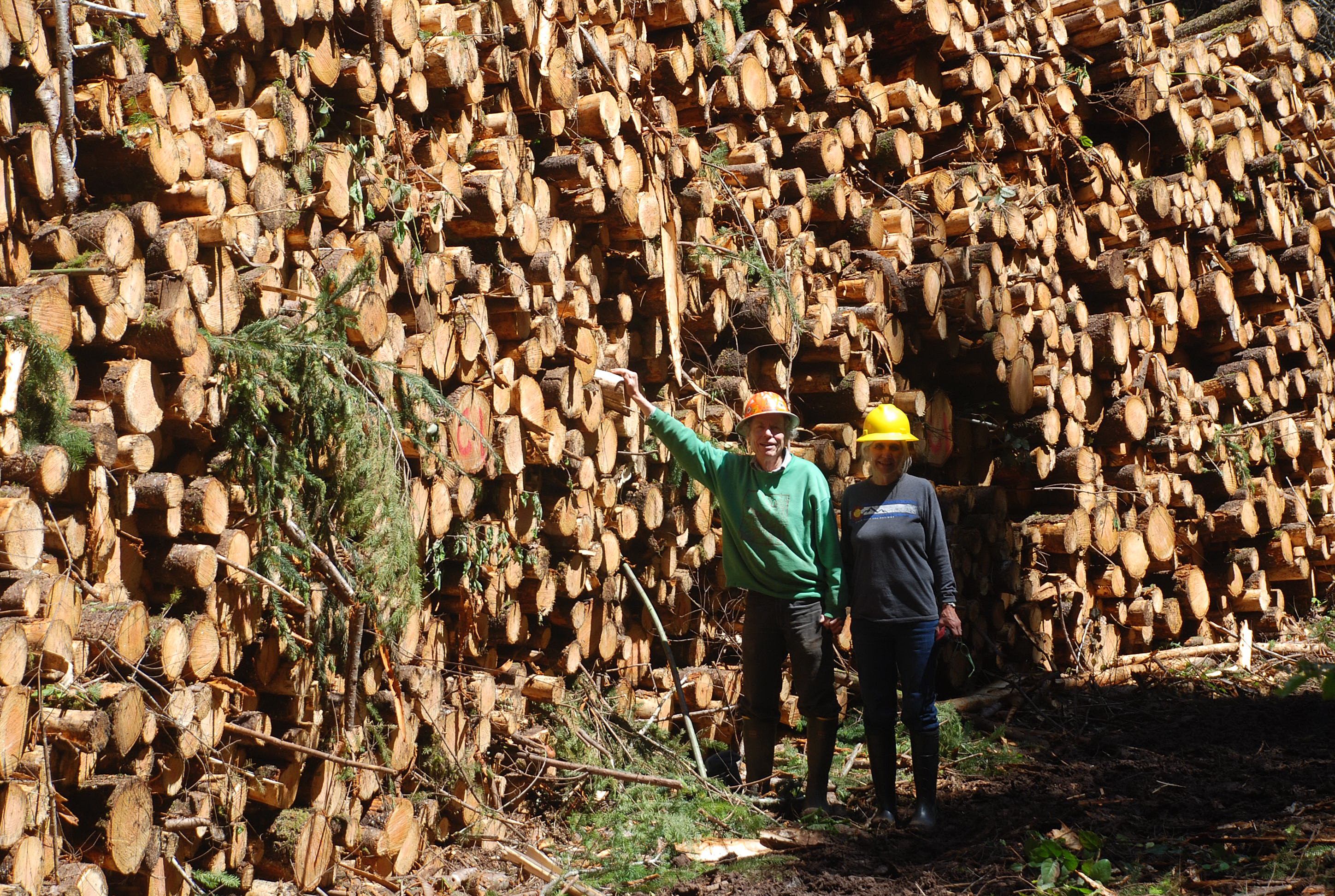 Eugene (.0001% of the Basin).
Eugene (.0001% of the Basin).
When Deerhorn was purchased, all of the roads were brushed-in and impassible. An old log culvert on the main road to the bottom of the property was collapsed. The Cafferata opened the roads, replaced the culvert, seeded the exposed soil with a grass mix suitable for wildlife, and graded the roads where needed. They established water-bars to cross drain and prevent water from running down the roads. Signs were installed at all water-bar locations and the two installed culverts and mapped to ensure frequent checking and maintenance. A steep sloped road running down to a culvert location was surfaced with rock to armor it preventing any possible erosion. That slope also has two cross-drain water-bars to disconnect it from the small non-fish stream below. The native-soil roads are kept vegetated. They are mowed with a weed-eater annually before summer to reduce fire risk. Buffers that exceed Best Management Practices in Oregon’s Forest Practices Act are maintained along the small non-fish streams on the property.
Similar activities have been done on the other Cafferata Family Forest properties following their purchase. The Lincoln County property, OR 5879; the Benton County property, OR 5821; and Western Lane property, OR 5842, have been prepared to protect against erosion. Culverts were installed where needed, existing culverts were unplugged, roads were graded to maintain functioning ditches, water-bars were constructed as needed, and native grasses were planted on native-soil roads.
On the Western Lane property roads are rocked except under a power-line right-of-way owned by Bonneville Power Administration (BPA). Road improvement and culvert work is scheduled by BPA in 2018.
Wildlife including threatened and endangered species: There is a wide range of wildlife on the Deerhorn property. The Cafferatas maintain a running inventory of identified species. They have recorded 37 species of birds, six species of small mammals, six species of reptiles and amphibians, black-tailed deer, Roosevelt elk, black bear, and cougar. In addition to direct observation and bird sounds, game cameras are also used. One priority is encouraging neo-tropical birds, grouse, and quail. They have seeded with a grass seed mix targeted for birds where they have exposed soil. A small pond was developed to provide water and for fire protection. It is used by birds, amphibians, and mammals.
Hardwood control on the property is designed to retain hardwood species for birds as well as to release conifers for wood production. Hardwood stands, hardwood clumps, and individual hardwood trees can be found on the property. Hardwoods are retained in mixed stands where they do not compete heavily with conifers. Snags and down-wood are retained except for safety hazards. When doing the brush-field conversions, residual conifers were retained for vertical diversity for nesting and roosting. Walk- in deer and elk hunting is allowed on the property, but not bird hunting.
When purchased, the Deerhorn property was encumbered by a Northern Spotted Owl nest site on adjacent Bureau of Land Management (BLM) property. A written plan was produced and approved to allow commercial thinning within 1/4th mile of the nest site.
On their Western Lane property, they have undertaken a project to convert a Bonneville Power Administration (BPA) easement from fields of Scotch broom to native shrubs and grasses. This is good habitat for neo-tropical birds and grazing for elk, deer, and wild turkey. The conversion is complete and in maintenance control. The area is heavily used now by elk and turkey.
Recreation and Aesthetics including special sites: One of the five goals for the Cafferata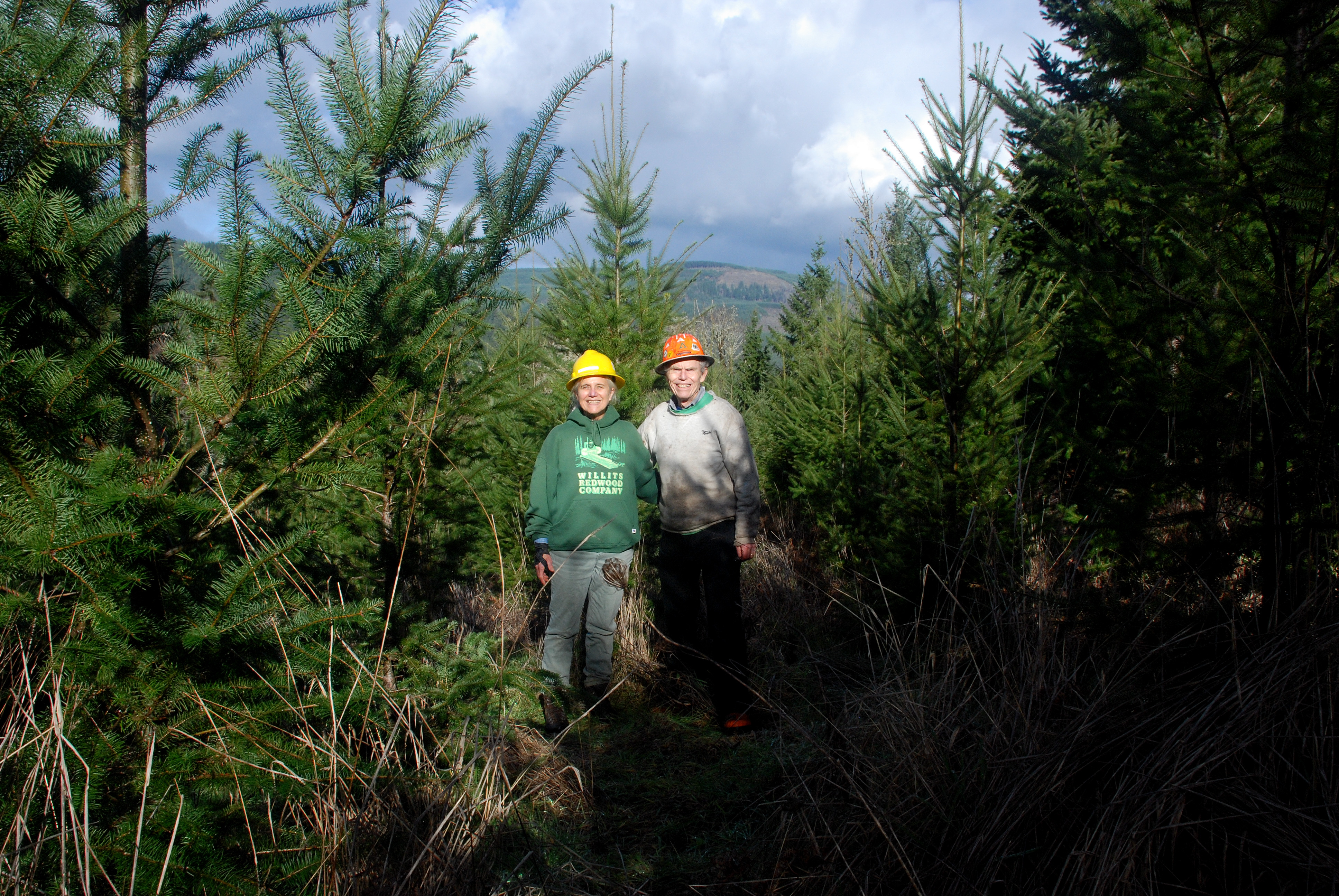 Family Forest
is that the forest serves as a family-gathering spot where family members can
appreciate the wooded landscape. On the Deerhorn property, they have
facilitated this by building and installing a picnic table and a swing, by
purchasing and installing an outhouse, and by creating an overnight-camping
area. The property has been used for many family picnics, birthday parties,
hikes, wildlife watching and over-night camping. Neighbors are invited to hike
and hunt deer on the property. A number of trails have been built on the
property to facilitate easy access for enjoying the rich diversity present;
Julie Creek Trail, Alder Trail, Big Log Trail, Cross-Over Trail are identified
on the property maps.
Family Forest
is that the forest serves as a family-gathering spot where family members can
appreciate the wooded landscape. On the Deerhorn property, they have
facilitated this by building and installing a picnic table and a swing, by
purchasing and installing an outhouse, and by creating an overnight-camping
area. The property has been used for many family picnics, birthday parties,
hikes, wildlife watching and over-night camping. Neighbors are invited to hike
and hunt deer on the property. A number of trails have been built on the
property to facilitate easy access for enjoying the rich diversity present;
Julie Creek Trail, Alder Trail, Big Log Trail, Cross-Over Trail are identified
on the property maps.
Each Christmas season the Cafferatas host a wreath-making party for family and friends, using native plants and trees from the property to make the wreaths. These events include a picnic lunch. The Deerhorn property has been used several times for this activity as well as their property in Western Lane County, OR 5842.
The Cafferatas have named the roads on the Deerhorn property and other properties for family members. Some family members have written poetry inspired by the property which is kept in the poetry section of the tree farm management plan. A few trees on the property have been named after figures from mythology. There are signs bearing their names. The largest trees on their 350-tree stand planted with third generation progeny seedlings are named Hercules, Samson, and Mr. Stretch.
Family forestry work projects on the property are considered recreation. Tree-planting, slash-burning, pruning, and trail maintenance are done as family projects. These activities gather the family together to work as a team. They track the number of times the property is used for recreation in their management plan.


